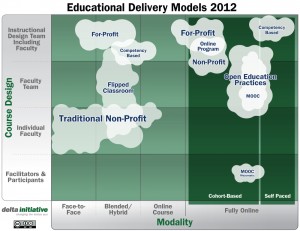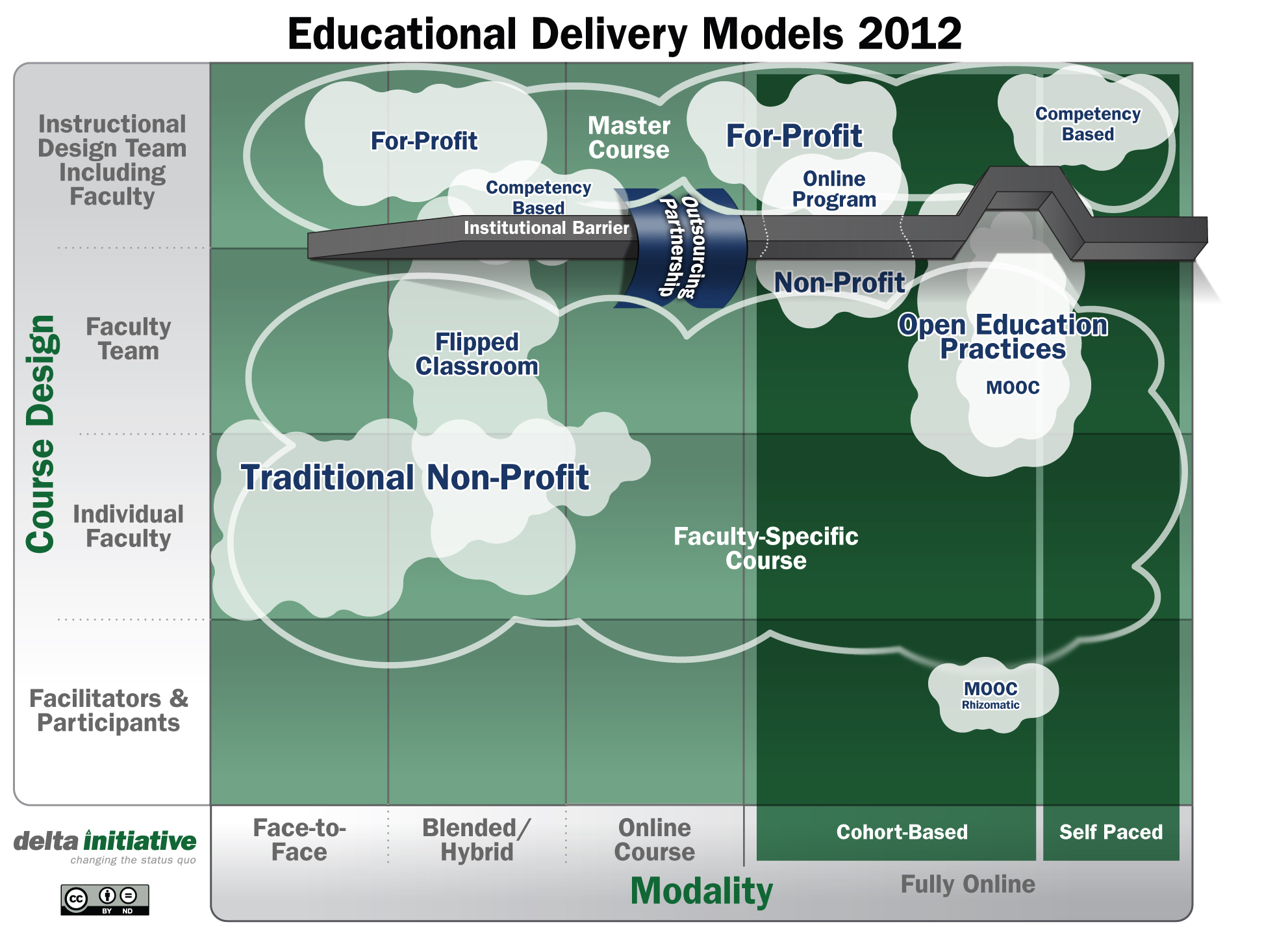In part 1 of this series of posts I presented a view of different educational delivery models based on course design and modality.
Why does it matter that we describe these educational delivery models with finer granularity than just traditional and online? Because the aims of the models differ, as do the primary methods of how these models are created and delivered.
To show an example of how the methods differ, let’s look at one of the most significant, but overlooked, concepts in this landscape – the master course. This concept of the master course changes the educational delivery methods of an institution, and in my opinion is the real differentiator between traditional institutions and for-profit institutions (both blended and fully online) and even non-profit fully-online organizations.
Master Course as Method for Scale and Access
For the past century in higher education, the core concept of course design is that an individual faculty member, or occasionally a small team of faculty members, designs and delivers each course. There may be some guidelines and policies from the institution, but after initial review of the course objectives and design, the course belongs to the faculty designing and teaching it. While there are many benefits to this model, there is a key challenge to consider.
How do you cost-effectively scale the course or program to provide greater access to more students given the explicit connection between course and faculty?
In most traditional institutions, the answer to this question has been the use of graduate students to teach a faculty member’s course or the large lecture course with hundreds of students. This approach has proven inadequate, however, as a general solution to scale and access.
A master course gets replicated into multiple, relatively consistent sections in a repeatable manner. In this approach, instructional design teams – typically including multi-media experts, quality assurance people and instructional designers – work with faculty members and / or subject matter experts to design a master course. Once designed, the master course is replicated in multiple sections that can be taught or facilitated by multiple instructors, typically adjunct faculty. The faculty members that are part of the design can also be instructors for a couple of sections, but by-and-large the sections are taught by instructors who were not part of the design team.
The master course concept changes the assumptions on who owns the course, and it leads to different processes to design, deliver and update courses that just don’t exist in traditional education. The implications of this approach or concept are significant. Because of these differences, there is in reality an institutional barrier that very few institutions can cross.
How do institutions that want to provide scale and access deal with this barrier? There appears to be three primary methods based on the current landscape.
Separate Organizations: Put Someone Else Across the Barrier
The most common method over the past decade or two has been for separate organizations to be created that will implement the master course concept.
The majority of for-profit organizations – at least the medium and large for-profits that operate at scale – are based on this concept, whether using online courses or even blended / hybrid courses.
There are non-profit organizations that have delivered online programs at scale, of course, but these have tended to be entirely new organizations within a higher education system. These new online organizations fit within the overall system governance, but the operations, budgets and academic oversight are provided by these unique organizations. Examples include Rio Salado College, University of Maryland University College, Colorado Community College Online, and Penn State World Campus. These organizations often have more in common with their for-profit brethren than with the other institutions within their system.
Many of the failures of traditional institutions or statewide systems to successfully create, grow and sustain online programs can be traced to organizational resistance from the rest of the system to the separate online organization.
Outsourcing or Partnerships: A Bridge Over the Barrier
Another approach is to outsource to or partner with another organization who already has experience and capabilities to implement a master course concept and the associated operations, while providing these courses through the traditional institution.
Western Governors University has succeeded lately in becoming the partner to build or provide online programs for state systems in Indiana, Washington and Texas. Their approach is competency-based education that gives credit to working adults who can demonstrate competency in a subject, rather than based on seat time.
There is also a burgeoning industry built around outsourced, for-profit service providers – companies that can outsource the curriculum and course development, as well as the operations, of an online program. This new category is called School as a Service, and some market estimates indicate future compound annual growth rates of 30%. Pearson has entered this market based on the model used with Arizona State University online. There are several other providers, including Embanet / Compass, 2tor, Academic Partnerships and others.
MOOCs: Move the Barrier
Perhaps the approach that is generating the most interest lately has been the Massively Openly Online Course (MOOC). In one version – typified by MITx, Stanford, Udacity and Udemy – the course itself is scaled to enable thousands of students to take the course from the faculty members who both design and lead the course. This design process can include a full instructional design team, but to date the scale of the course replaces the master course concept. In other words, this approach provides the scale and access without resorting to a master course concept.
With effective use of educational technology, there are methods to reach scale and access – as long as institutions are aware of the barrier and have a plan to deal with it.
Next up, I’ll share some thoughts on the differing aims of the educational delivery models in this landscape.
Update: Updated graphic to clarify labels


Phil,
It seems that these three approaches to addressing the master course and scale go back, at least to a certain extent, to the business model or business goal. Pedagogical control, efficiency, and provable efficacy are key goals of the large for-profit institutions and the separate organizations model seems to fit well. While I personally like the open design (and learning philosophy) of MOOCs, I don’t see a strong alignment with for-profit goals.
Those were my initial observations. My questions is whether or not you see MOOCs as potentially expanding their reach and finding a place in for-profit institutional models with course designers etc.
Rob, I think MOOCs are the second wave (after open courseware and iTunesU in the first wave) – moving form massively open online content to massively open online course. I could see the potential for the for-profits to adopt MOOCs, or their version of the third wave, into their offerings. They would need to address the accreditation issues by moving from continuing ed or badges into being part of an accredited program.
Of course, this potential third wave would not be fully open. So if the for-profits adopt, it would be a massively scaled online course. Good question – what are your thoughts?
That makes sense. The key, as you have pointed out, is measurement/control that can support accreditation. Some of that might seem contradictory to the design philosophy of MOOCs, but I think it could work if we shifted to competency-based curricula and placed a much greater emphasis on self-assessment. Interestingly, this is what has happened in the accreditation process itself — self-assessment by institutions and their own learners has become a much bigger part of the evaluation process.